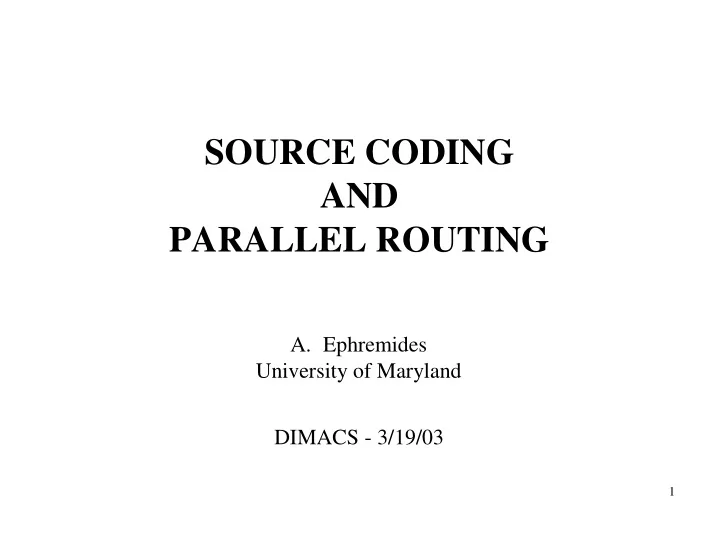

SOURCE�CODING AND PARALLEL�ROUTING A. Ephremides University�of�Maryland DIMACS�- 3/19/03 1
CROSS-LAYER�ISSUES Compression�(Layer�6)�and�Transmission�(Layer�1) • energy�efficiency�perspective. • tradeoff�between�transmission�(RF)�and�processing�energy. • in�context�of�sensor�networks,�added�feature�of�detection�gives�a�special� slant�to�compression Compression�(IT�source�coding)�and�Routing�(Layer�3) • coupling�of�information�theory�and�networking. • reveals�novel�trade-offs 2
MAIN�IDEA - Multiple�Description�coding • different�(coupled)�representations�of�source�signals. • each�description�requires�fewer�bits�than�a�single�description. - Parallel�Routing • redundant�transmission�of�packet�copies�over�separate�routes. • protects�against�long�delays�and/or�errors - Joint�Compression/Routing • send�each�description�over�a�separate�route • “cancel”�redundancy�with�compression - Trade-off�study 3
� � BACKGROUND - Source�emits�i.i.d.�Gaussian�variables�(0-mean,�unit�variance). - D�=�mean�squared�error�distortion - R�=�representation�rate�(bits/symbol) - -2R D�=�2 - Symbols�are�sent�to�a�destination�node;�so�modify�distortion�measure - T:�delay ≤ -2R 2 , T � D�=� � 1,����� T> � - Think�of�each�symbol�as�a�separate�“packet”�of�length�R�bits 4
� � � � � � � � BACKGROUND�(Continued)� - Multiple�(i.e.�Double)�Description�Coding� (Ozarow,�ElCamal/Cover,�Wyner etal circa�’80-’82) + = R R R 1 2� -2(R +R ) 2 1 2 � ≤ ≤ d = , T �&�T � 0 1 2 -2R -2R -2(R +R ) 2 +2 -2 1 2 1 2 � ≤ � -2R d =2 , T �&�T > D�=� 1 � 1� 1 2 ≤ � -2R d =2 ,��T > �&�T 2 2 1 2 � 1�������������������������������������,�� T > �&�T > � � 1 2 - Each�description�is�sent�to�destination�over�separate�route - ith�description�has�rate�R i ,�individual�mse�distortion�d i ,�and�delay�T i - d 0 is�joint�distortion 5
� ✁ BACKGROUND�(Continued) - Previous�formula�describes�the�boundary�of�the�achievable�rate-distortion� region. - “Inside”�the�region�we�have� -2R (1- ) d =2 i i i� 1 = − 2(R +R ) d 2 . 1 2 0 − Π − Λ 2 1 ( ) − Π − Λ = − 2(R +R ) where� �=�(1-d )(1 d )& d d 2 1 2 1 2 1 2 ≤ ≤ where�0 1�represents�the�"redundancy"�of�the� i representations Note�:� δ i → 0,�no�redundancy,�“lean” compression,�“effective” rate�R i ,� - minimum�distortion. δ i → 1,�maximum�redundancy,�ineffective�compression,�“effective” rate 0,�maximum�distortion Choice�of� δ affects�distortion-rate�values�and representation�complexity - 6
SIMPLE�NETWORK�MODEL λ N λ s λ s λ R 1 C 1 E 1 q D MDC� λ s s λ decoder MUX R 2 λ s C 2 E 2 λ s λ N λ �=�source�symbol�rate�("packets"/s) Coding�Parameters S λ = q�=�network�parameter other�traffic�rate R α Ν 1 = R = + λ λ + λ initially�C C R �=� 1 2 1 2 S N δ δ + = R R R�=�bits/packet 1, 2 1 2 - noiseless�transmission 7
AVERAGE�DISTORTION [ ] [ ] [ ] = ≤ ∆ ≤ ∆ + ≤ ∆ > ∆ + E D d T T d T T Pr , Pr , o 1 2 1 1 2 [ ] [ ] > ≤ ∆ + > ∆ > ∆ d T T T T Pr , 1 Pr � , 2 1 2 1 2 Objective:���Min�E[D] by�choice�of� α ,� δ 1 ,� δ 2 ,�q (for�fixed�R,�C 1 =�C 2 =�C,�� λ ,�� ∆ ) - Need�queuing�analysis�to�express�the�delay�probability (use�M/G/1�formulas) - Perform�Numerical�Minimization - *�=�will�denotes�optimal�values 8
FIRST�RESULTS - Phase�Transition�Behavior q�=�1/2 q* E(D*) q* 1/2 λ c λ λ c λ - Beyond�a�critical�load�value�do�not�mix�traffic� (i.e.�dedicate�each�description�completely�to�its�path) - Below�that�value�mix�thoroughly�(50-50) 9
FIRST�RESULTS�(Continued) δ * α *�=�R 1 /(R 1 +R 2 ) .82 1/2 λ λ c λ λ c Below� λ c�encode�symmetrically�(no�advantage Gradually�drop�the�redundancy to�differentiate�descriptions) Factor�to�zero�(“lean”�compression) ρ 2 ρ 1 Load - Keep�the�load�on�one�queue (or�rate) below�saturation�and�send�all� the�remaining�traffic�to�the� other�queue λ c λ λ R ρ = λ = i R i i C C 10 i
INTELLIGENT�SWITCH - drop�packets�whose�sojourns�times�exceed� ∆ (while�still�in�queue). - only�change:�“impatient�customer”�queuing�behavior 1 MDC q = 1 ( ) IS q = ( ) 2 2 = MDC q q *( *) E D ( ) = IS q q ( *) Note:��At�heavy�loads intelligent�switch�with dumm mixing�is�worse than�intelligent�mixing with�dumm switch λ c λ Explanation:��- IS�drops�packets�“uniformly”�at�both�queues - Optimal�mixing�gives�up�on�one�queue�totally�(garbage�bag) 11 but��keeps�one�queue�maximally�useful
PROBING�FURTHER - So�far� R was�fixed�(total�rate) - As� λ increases,�we�may�be�able�to�control�the�load�by� manipulating�packet�lengths�without�the�constraint�that� + = R R fixed 1 2 - If�there�is�an�optimal�R*,�by�symmetry�we�should�have R * = = R R * * 1 2 2 - Also,�since�both�queues�would�be�equally�loaded,�packets�would� be�lost�with�low�probability�at�both�as�we�decrease� R ;�hence�we� ∗ ∗ δ , δ should�choose�������������to�minimize�d 0 1 2 − R * + R * 1 2 2 δ = δ = ∗ ∗ - In�fact,�then,� log 1 2 R * 2 − = R * d * 2 & 2 0 - Not�optimal 12
CONFIRMATION = MDC IS q q *&� �( *) E D ( ) SDC �with�R* MDC �with�R* λ c λ Even�SDC�with�optimal�R*�outperforms�MDC*�with�IS�at� high�loads 13
CONFIRMATION�(CONTINUED) - If�instead�of�minimizing�d 0� we�minimize�E[D]�we�find�that�both�R *� and E(D)�are�indistinguishably�close�(hence,�intuition�was�good) - At�very�low�loads�( λ → 0),�one�might�expect�that�the�optimum�R * might increase�without�bound. - This�is�not�the�case�(very�long�packets�increase�the�delay�sufficiently to�wipe�out�distortion�gains) R * MDC * SDC 14 λ
FURTHER�THOUGHTS - Are�these�trade-offs�extendable�to�non-Gaussian�symbols�and�non- trivial�networks�paths? - Can�we�translate�the�results�to�practical�compression�schemes? - What�are�the�energy�implications�of�the�trade-off?��Do�we�spend� more�or�less�energy�when�we�use�parallel�paths�with�multiple� descriptions? - What�happens�if�noise�is�added�in�the�system? - What�happens�in�a�wireless�environment�where�inadvertent� multicasting�occurs? 15
Recommend
More recommend